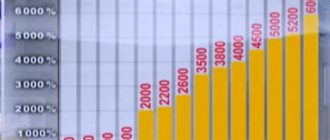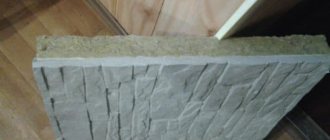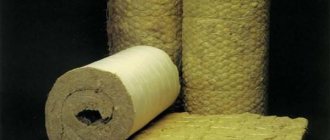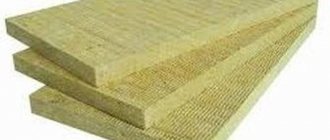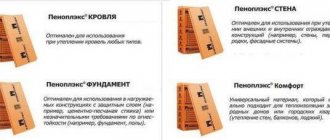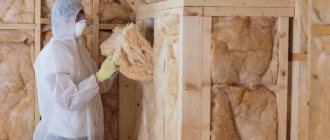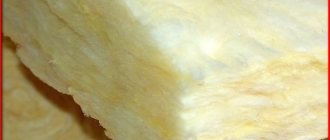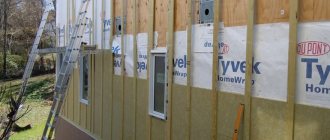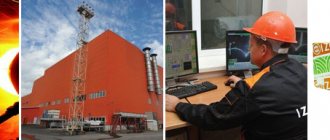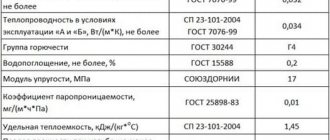About chemical resistance, GOST and fire safety
GOST regulates the composition of the material described in this article, as well as its specific properties. In addition, GOST standardizes the sizes of mineral wool slabs:
- thickness should be between 4-15 centimeters;
- width - either 50, 60, or 100 centimeters;
- and finally, length - 100 or 200 centimeters.
In terms of fire safety, mineral wool can be of two classes:
- G1;
- G2.
These classes determine the possibility of using the material on objects that pose a danger from the point of view of ignition. Thanks to its properties, it prevents the destruction of load-bearing structures, as well as the object as a whole. Over the course of many decades, deformation does not in any way affect the shape of the insulation. Mineral wool absorbs vibrations created by walls, ensuring silence and comfort in the house.
Note! The durability of mineral wool is achieved due to its resistance to chemicals. The influence of chemically active substances and solvents does not affect the integrity of the structure. For this reason, mineral wool is actively used in construction and industry - it is used to insulate utility lines, tanks, and various equipment.
When insulating residential buildings using mineral wool, new technologies for creating frame-type objects are being created. This insulation can significantly reduce construction costs, while heating costs will not increase. Mineral wool can be used to insulate floors along joists, ceilings, verandas, walls, the only condition is that after installation the material must be ventilated.
Video - Insulating walls with mineral wool
Mineral wool (mats and slabs, GOST standards, description, application, supply)
Characteristics: Mineral wool (depending on the type of raw material) can have a different fibrous structure, specified technologically: horizontally layered, vertically layered, corrugated or spatial, which expands the possibilities of its use in certain structures.
It is characterized by significant resistance to high temperatures and chemicals. Mineral wool also has excellent heat and sound insulation properties.
Currently, a significant amount of mineral wool is produced, which is widely used in construction. Its areas of application are thermal insulation of walls and ceilings; mineral wool is also widely used for insulation of high-temperature surfaces (furnaces, pipelines, etc.), fire protection of structures and as a soundproofing material in partitions and acoustic screens.
Scope of application: Mineral wool is intended for the manufacture of heat-insulating and sound-proofing products, as well as as a heat-insulating material in construction and industry for insulating surfaces with temperatures up to + 700 °C.
It must be remembered that in products made of mineral (stone) wool on a synthetic binder (phenol-formaldehyde resins) at a temperature of about 300-350 ° C, the process of destruction of the binder begins.
Application:
As unloaded insulation of horizontal, vertical and inclined building envelopes of all types of buildings. In external insulation systems of plaster type. As a thermal insulation layer in suspended ventilated facades. In systems with insulation on the inside of the building envelope. In systems with insulation inside the building envelope (three-layer concrete or reinforced concrete panels, three-layer sandwich panels with metal sheathing, layered masonry). As thermal insulation of industrial equipment, tanks and pipelines of heating networks, main oil and gas pipelines, process pipelines of power plants, metallurgical, petrochemical and other industrial enterprises. As a lower heat and sound insulation layer in multi-layer flat roof coverings, including when laid on a surface without a cement screed. As a heat and sound insulating layer in flat roof coverings, including when laid on a surface without a cement screed. As a top heat and sound insulating layer in multi-layer flat roof coverings, including when laid on a surface without a cement screed. There are a number of documents (GOSTs) according to which the main indicators of mineral wool products are regulated: 1. GOST 9573-96 “Thermal insulating slabs of mineral wool on a synthetic binder” 2. GOST 21880-94 “Thermal insulating mats made of mineral wool” 3. GOST 22950 -95 “Mineral wool slabs of increased rigidity with a synthetic binder. Technical conditions" Most manufacturers currently produce mineral wool according to their own Technical Conditions (TU), these documents prescribe much higher requirements for the insulation produced than those that appeared in GOST.
ADDITIONAL INFORMATION:
Mineral wool mats GOST 21880-94
Heat-insulating mats made of mineral wool GOST 21880-94 are sheets of the finest interwoven fibers of mineral wool, stitched with special fire-resistant threads - roving on any base (lining), or without it.
Depending on the type of covering material, mats are divided into types:
M1 - without lining material;
M2 – on a metal mesh..;
M3 - on fiberglass...
The covering material can be on one or both sides.
Depending on the density, mats are divided into brands: 75, 100, 125 (kg/m?) .
Mat sizes : width 1000 mm, length from 1000 to 3000 mm (standard 2000 mm), thickness from 60 to 100 mm.
Packaging: rolls wrapped in stretch film, ends open.
Specifications:
- High chemical resistance,
- Non-flammable (fire insulation and fire protection),
- Used at temperatures from - 180 to + 700°C,
- Resistance to biodegradation,
- High degree of noise absorption.
Physical and mechanical properties of M-100 mats:
- Density 85-110 kg/m?,
- Thermal conductivity at t 283°K (10°C) 0.036 W/(m*K),
- Compressibility, no more than 40%,
- Elasticity, not less than 75%,
- Humidity, no more than 2%,
- Acidity module 1.38.
products are certified according to GOST 21880-94.
Mineral wool is obtained by melting rocks, without adding any chemical compounds. In the mats it is fixed mechanically by piercing with glass threads and, unlike mineral wool boards, the piercing mats do not contain binder resins containing formaldehyde. Therefore, mineral wool mats were and remain the most environmentally friendly insulation of all that exist today.
The thermal insulation properties of mats, like all mineral wool products, are due to the content of a large number of air pores and channels in them - about 95% of the total volume containing air in a stationary state, the thermal conductivity of which is very low.
Main properties of mineral wool mats:
- Effectively prevent the release of heat into the environment;
- They can withstand high temperatures, even at a temperature of 700°C they do not burn, do not emit any harmful substances into the environment, and do not lose their properties;
- They are not a source of air pollution, which is confirmed by a hygienic certificate;
- They are resistant to microorganisms and rodents (inorganic material is not destroyed and does not provide a basis for the growth of microorganisms);
- The unique combination of elasticity and elasticity allows the mats to take the shape of the surface being finished. Due to the tight fit of the mat to the surface, the likelihood of heat leakage is significantly reduced;
- Insulated structures are made as light as possible. At the same time, their heat resistance does not decrease. In such enclosing structures, the thickness of the load-bearing part depends on the strength of the structural material, and high heat resistance is achieved due to the high thermal resistance of mineral wool mats;
- Do not increase the corrosive aggressiveness of the external environment in contact with metal materials;
- The use of longitudinal strengthening of mats by stitching with roving under conditions of increased vibration load allows them to maintain mechanical and thermophysical characteristics throughout their service life, which reaches 50 years;
- They provide increased sound insulation, which is an important indicator in the construction of buildings.
- The absence of synthetic substances in the component of pierced mats allows the use of pierced mats on objects with high storage requirements or when working with flammable materials;
- Stitched mats are an environmentally friendly “breathing” heat-insulating material that “does not clog” the insulated room; they are used for a long time without destruction.
Application:
- Thermal insulation of pipelines of heating networks, main oil and gas pipelines, process pipelines of various diameters of enterprises of all industries at a temperature of the insulated surface from -180 to 700°C;
- As unloaded thermal and sound insulation of industrial equipment: boilers, steam generators, heat exchangers, turbines, drying cabinets, industrial refrigerators, tanks, pipelines, air ducts, air conditioning and ventilation systems, as well as household appliances;
- As unloaded thermal insulation in industrial and civil construction, and insulation in lightweight frame-type enclosing structures;
- For thermal insulation of internal walls of residential premises, partitions, floors and ceilings, attics, attics, for insulation of panel structures, since they do not contain a binder that evaporates into the environment in the form of toxic gases harmful to the human body. Effectively used for thermal insulation of steam rooms, baths, saunas;
- As sound-absorbing materials of the middle layer in the construction of frame-sheathing partitions, cladding of multi-storey floors, additional sound insulation of ceilings and walls in industrial, civil and residential construction;
- They are used in the manufacture of fireproof structures, sheathing, fire partitions, and as a fire separating layer in three-layer structures.
Mineral wool boards (minslab)
– these are thermal insulation boards made of mineral wool on a synthetic binder with or without water-repellent additives (HFA), intended for thermal insulation of building structures in conditions that exclude contact of products with indoor air, and industrial equipment. Mineral board, as well as mineral wool mats, differs from insulation made on the basis of other materials in that it is resistant to high temperatures and most aggressive chemical substances: alkalis, oils, solvents.
The advantages of mineral wool boards also include the following:
- Low moisture absorption;
- Fire resistance;
- The fibrous structure provides elasticity and high strength to the material;
- Due to its fibrous structure, such a slab is a good sound insulator;
- Durability;
- High thermal insulation properties;
Lightweight and easy to install, easy to cut and lay.
Mineral wool boards have different hardness and density, they are conventionally divided into: soft - density up to 75 kg/m?, semi-rigid - density from 76 to 125 kg/m?, hard - density from 126 to 225 kg/m?, plates of increased rigidity (PPZh), manufactured according to GOST 22950-95 - density from 160 to 225 kg/m?.
Thermal insulation slabs made of mineral wool on a synthetic binder according to GOST 9573-96
According to GOST 9573-96, mineral wool slabs are produced in four grades: 75, 125, 175, 225.
The nominal dimensions of the slabs must correspond to those indicated in the table:
| Brand | Length, mm | Width, mm | Thickness, mm |
| 75 | 1000; 1200 | 500; 600; 1000; | 60; 70; 80; 90; 100; 110; 120; |
| 125 | 50; 60; 70; 80; 90; 100; | ||
| 175; 225 | 40; 50; 60; 70; 80; | ||
| Note - By agreement with the consumer, it is possible to produce slabs of other sizes. | |||
The symbol of the slabs must consist of the initial letter of the product name (P), the brand designation, the dimensions of the slabs in length, width, thickness in millimeters and the designation of this standard.
An example of a symbol for a slab of grade 125 with a length of 1000, a width of 500 and a thickness of 50 mm: P 125-1000.500.50 GOST 9573-96.
Characteristics
Maximum deviations of the nominal dimensions of the slabs, mm, should not exceed: +10/ - 10 in length + 10/ -5 in width +7/ -2 in thickness for slabs of grades 75, 125, 175 +5/ -3 in thickness for slabs brand 225
For slabs of grade 225, the difference in diagonal lengths should not exceed 10 mm, and the difference in thickness should not exceed 5 mm.
In terms of physical and mechanical properties, slabs manufactured in accordance with GOST 9573-96 must meet the requirements given in the table:
| Indicator name | Value for slab grades: | ||||||
| 75 | 125 | 175 | 225 | ||||
| Density, kg/m3, no more | 75 | 125 | 175 | 225 | |||
| Thermal conductivity, W/(m x K), no more, at temperature, K: | |||||||
| 298 +- 5 398 +- 5 | 0,047 | 0,049 | 0,052 | 0,054 | |||
| 0,077 | 0,072 | 0,070 | — | ||||
| Compressibility, %, no more | 20 | 12 | 4 | — | |||
| Compressibility after sorption humidification,%, no more | 26 | 16 | 6 | — | |||
| Compressive strength at 10% deformation, MPa, not less | — | — | — | 0,04 | |||
| Compressive strength at 10% deformation after sorption moistening, MPa, not less | — | — | — | 0,03 | |||
| Water absorption,% by weight, no more | — | — | — | 30 | |||
| Content of organic substances, % by weight, no more | 3 | 4 | 5 | 6 | |||
| Humidity, % by mass, no more | 1 | 1 | 1 | 1 | |||
In terms of flammability, slabs of grade P-75 should belong to the group NG (non-flammable), grades P-125 and P-175 - G1 (slightly flammable), grade P-225 - G2 (moderately flammable) according to GOST 30244-94 and Federal Law - 123.
The amount of harmful substances released from slabs at temperatures of 20 and 40°C should not exceed the maximum permissible concentrations established by sanitary inspection authorities.
Recommended area of application of thermal insulation boards made of mineral wool with a synthetic binder, manufactured in accordance with GOST 9573-96
| Brand of slabs | Application area |
| 75 | As unloaded thermal insulation in horizontal building enclosing structures For thermal insulation of equipment with the temperature of the insulated surface from minus 60 to +400°C |
| 125 | As unloaded thermal insulation in horizontal building enclosing structures As insulation in lightweight frame-type enclosing structures For thermal insulation of equipment with insulated surface temperatures up to +400°C |
| 175 | As thermal insulation in vertical and horizontal building enclosing structures. As insulation in lightweight frame-type enclosing structures. As a thermal insulation layer in three-layer concrete and reinforced concrete enclosing structures (type A mineral wool slabs) For thermal insulation of equipment with insulated surface temperatures up to 400°C |
| 225 | As thermal insulation subjected to load in vertical and horizontal building envelopes. As a thermal insulation layer in three-layer concrete and reinforced concrete envelopes (type A mineral wool slabs). In coverings made of profiled flooring or reinforced concrete For external thermal insulation of walls followed by plastering or installation of a protective covering layer (type A mineral wool slabs For thermal insulation of equipment with a temperature of the insulated surface up to 100° |
Mineral wool slabs of increased rigidity with a synthetic binder (PPZh) according to GOST 22950-95
Mineral wool slabs of increased rigidity on a synthetic binder with water-repellent additives, made from hydromass using wet molding technology (PPZh slabs) are intended for thermal insulation of building envelopes: floors, as well as for insulation of coatings made of profiled metal flooring or reinforced concrete without a screed and leveling device layer, in conditions that exclude contact of products with indoor air.
Nominal dimensions of slabs and maximum deviations:
| PPZh type slabs | ||||||
| Brand | Length, mm | Width, mm | Thickness, mm | |||
| Nom. | Prev. Off | Nom. | Prev. Off | Nom. | Prev. Off | |
| 200 | 1000 | +10 -10 | 500 | +5 -5 | 40; 50; 60; 70; 80; | +5 -3 |
Physical and mechanical characteristics of the PPZh-200 plate:
| Indicator name | PPZh-200 |
| Density, kg/m3 | 200+-25 |
| Thermal conductivity, W/(mK), at average temperature (25+-5)°C, no more | 0,052 |
| Compressive strength at 10% deformation, MPa, not less | 0,100 |
| Compressive strength at 10% deformation after sorption moistening, MPa, not less | 0,080 |
| Mass fraction of organic substances, %, no more | 10 |
| Water absorption,% by weight, no more | 30 |
| Humidity, % by mass, no more | 1 |
In terms of flammability, PPZh-200 slabs belong to group G2 (moderately flammable) according to GOST 30244-94 and FZ-123.
The amount of harmful substances released from mineral wool slabs at temperatures of 20 and 40 ° C should not exceed the maximum permissible concentrations established by sanitary inspection authorities.
Directions for use of PPZh-200
- Thermal insulation work using PPZh-200 slabs should be combined with roofing work . Laying the slabs and installing the bottom layer of the rolled waterproofing carpet must be done in the same shift. The slabs should be laid “on themselves”.
- It is advisable to pre-glue a layer of roofing material onto the slabs, which increases their punching strength and prevents the penetration of bitumen mastic into the thickness of the thermal insulation during roofing work.
- When installing thermal insulation from two layers of slabs, the seams between the slabs must be done “in a separate manner.”
- To obtain a flat surface for the sticker of the waterproofing carpet and to avoid possible damage to it in places where there are differences in heights between adjacent slabs, ledges between them of more than 5 mm must be cut off.
Heat-insulating energy slabs based on basalt wool grade PTE according to TU 5761-001-00126238-00
PTE-40
Application: Used as unloaded thermal and sound insulation in horizontal building enclosing structures. As insulation and soundproofing material in lightweight frame-type enclosing structures. Pitched roofs, frame walls, partitions, ceilings, floors with joists. As a soundproofing material for floors on joists. In three-layer structures in residential, industrial and civil construction. For thermal insulation of equipment with a temperature of the insulated surface from -120°C to +700°C.
Characteristics: Density, kg/m? 35-45; Dimensions, mm 1000 x 500 x 50-200; Thermal conductivity coefficient at 25 °C, W/m? 0.038.
PTE-50
Application: Used as unloaded thermal and sound insulation in horizontal building enclosing structures. As insulation and soundproofing material in lightweight frame-type enclosing structures. Pitched roofs, frame walls, partitions, ceilings, floors with joists. As a soundproofing material for floors on joists. In three-layer structures in residential, industrial and civil construction. For thermal insulation of equipment with a temperature of the insulated surface from -120°C to +700°C.
Characteristics: Density, kg/m? 40-56; Dimensions, mm 2000*1000 (1000 x 500) x 40-150; Thermal conductivity coefficient at 25 °C, W/m? 0.036.
PTE-75
Application: Used as unloaded thermal and sound insulation in horizontal building enclosing structures. As insulation and soundproofing material in lightweight frame-type enclosing structures. Pitched roofs, frame walls, partitions, ceilings, floors with joists. As a soundproofing material for floors on joists. In three-layer structures in residential, industrial and civil construction. For thermal insulation of equipment with a temperature of the insulated surface from -120°C to +700°C.
Characteristics: Density, kg/m? 57-83; Dimensions, mm 2000*1000 (1000 x 500) x 40-120; Thermal conductivity coefficient at 25 °C, W/m? 0.036.
PTE-100
Application: As thermal insulation in vertical and horizontal building envelopes. As insulation in lightweight frame-type enclosing structures. For thermal insulation of equipment with the temperature of the insulated surface: P slabs from -120°C to + 400°C; PTE slabs from -120°C to + 700°C.
Characteristics: Density, kg/m? 84-110; Dimensions, mm 2000*1000 (1000 x 500) x 40-120; Thermal conductivity coefficient at 25 °C, W/m? 0.038.
PTE-125
Application: As thermal insulation in vertical and horizontal building envelopes. As insulation in lightweight frame-type enclosing structures. For thermal insulation of equipment with the temperature of the insulated surface: P slabs from -120°C to + 400°C; PTE slabs from -120°C to + 700°C.
Characteristics: Density, kg/m? 111-138; Dimensions, mm 2000*1000 (1000 x 500) x 40-120; Thermal conductivity coefficient at 25 °C, W/m? 0.038.
PTE-150
Application: As thermal insulation subject to load in vertical and horizontal enclosing structures. As a thermal insulation layer in three-layer concrete and reinforced concrete enclosing structures. As a thermal insulation layer in coverings made of profiled flooring or reinforced concrete. For external thermal insulation of walls followed by plastering or installation of a protective covering layer. For thermal insulation of equipment with a temperature of the insulated surface from -120°C to + 700°C. Fire protection agent for building structures.
Characteristics: Density, kg/m? 139-155; Dimensions, mm 2000*1000 (1000 x 500) x 40-100; Thermal conductivity coefficient at 25 °C, W/m? 0.038.
PTE-175
Application: As thermal insulation subject to load in vertical and horizontal enclosing structures. As a thermal insulation layer in three-layer concrete and reinforced concrete enclosing structures. As a thermal insulation layer in coverings made of profiled flooring or reinforced concrete. For external thermal insulation of walls followed by plastering or installation of a protective covering layer. For thermal insulation of equipment with a temperature of the insulated surface from -120°C to + 700°C. Fire protection agent for building structures.
Characteristics: Density, kg/m? 156-190; Dimensions, mm 2000*1000 (1000 x 500) x 40-80; Thermal conductivity coefficient at 25 °C, W/m? 0.038.
PTE-200
Application: As thermal insulation subject to load in vertical and horizontal enclosing structures. As a thermal insulation layer in three-layer concrete and reinforced concrete enclosing structures. As a thermal insulation layer in coverings made of profiled flooring or reinforced concrete. For external thermal insulation of walls followed by plastering or installation of a protective covering layer. For thermal insulation of equipment with a temperature of the insulated surface from -120°C to + 700°C. Fire protection agent for building structures.
Characteristics: Density, kg/m? 191-230; Dimensions, mm 2000*1000 (1000 x 500) x 40-50; Thermal conductivity coefficient at 25 °C, W/m? 0.039.
Heat-insulating boards of the “TEPLIT” brand according to TU 5762-009-47838590-08
They are used for thermal insulation of a wide range of building structures. They are made from basalt energy wool (VBE) on a synthetic binder with water-repellent additives (HFD).
Thermal insulation boards "Teplit Light Super"
Thermal insulation slabs made of mineral wool on a synthetic binder, hydrophobized, intended for use as unloaded thermal and sound insulation of horizontal, vertical and inclined building envelopes of all types of buildings, including low-rise and cottage types of individual development; for thermal insulation of industrial equipment at a temperature of the insulated surface from -120°C to +700°C.
| Characteristics of "Teplit Light Super" | |
| Density, kg/m?, no more | 25-35 |
| Thermal conductivity, W/mK, no more, at temperature: | |
| 298(+ 5) °K 398(+ 5) °K ?? ?? | 0,038 0,050 0,040 0,043 |
| Compressibility, % no more | 30 |
| Compressibility, after absorption hydration, % no more | 40 |
| Humidity by mass, % no more | 1 |
| Water absorption during partial immersion by mass, % not more than | 35 |
| Water absorption at full immersion by volume, % no more | 2 |
| Content of organic substances, % no more than | 2,5 |
| Vapor permeability, mg/(mchPa), no more | 0,3 |
Our supply of thermal insulation materials details on the website www.tekhnoprom42.rf
List of products: thermal insulation materials: P-75 P-125 P-175 P-225 PTE-40 PTE-50 PTE-75 PTE-100 PTE-125 PTE-150 PTE-175 PTE-200 PPZh-200 Teplit-3K , Teplit-V, Teplit-S, Teplit-sandwich, sandwich panels. Thermal insulation mats are MBPE, MTPE, lined with metal mesh, lined with T-23 fiberglass. Energy cylinders TsTE. Energy cord ShTE.
Mineral wool thermal insulation mats GOST 21880-94 M1 M2 M3 M-75, M-100, M-125.
Basalt heat-insulating mats, pierced grades BSTV, MTB, TIB, MBTV, MPB, MTBZO, with or without lining material. Fireproof products. Dispatch within the Russian Federation, delivery to the buyer, discounts from factory prices.
Subscribe and stay with us:
Last modified: 12/24/2013
The article was posted by Tekhnoprom LLC.
Back to all articles
comments powered by HyperComments
Similar articles
Built in the USSR: the tallest chimney in the world It is noteworthy that the design of the reinforced concrete chimney for the Ekibastuz State District Power Plant-2 itself was not unique.
A year earlier, Teploproekt prepared working drawings of a similar facility for the Norilsk MMC. Leveling the floor for laying flooring Modern flooring, such as PVC tiles or laminate, place high demands on the base for installation.
Material Specifications
Due to the properties of the raw material, mineral wool does not burn even in direct contact with fire. Most of the fibers in it are silicates, therefore, the technical parameters of the material are quite high due to the production technology. Below are the most significant properties that must be taken into account when thermally insulating facades and producing sandwich panels:
- vapor permeability ranges from 0.5-0.53 mchPa;
- thermal conductivity is 40-53 watts per m per K;
- the moisture absorption rate throughout the entire volume of the material is 1.5 percent;
- maximum density - 200 kilograms per cubic meter;
- compression strength – about 0.6 megapascal;
- and finally, the moisture to weight ratio is about 3-5 percent.
Note! There are also special boards of this material used exclusively for roof insulation - we are talking about hydrophobized heat insulation boards.
In addition, there is rolled mineral wool, and also in the form of mats. Specific parameters depend on the silicate components (if up to 99 percent) and the binding element of organic origin:
- magnesium, calcium oxide - from 20 to 35 percent;
- silica - from 35 to 45 percent;
- potassium, sodium oxide – from 1 to 8 percent;
- alumina - from 14 to 25 percent.
Note! The indicators presented above are determined in relation to the weight of mineral wool.
To reduce the level of humidity, a special hydrophobic impregnation is used. Thanks to it, such technical characteristics of mineral wool appear as moisture resistance and high vapor permeability (thanks to the latter, the material can “breathe”). And moisture, having overcome all layers of insulation, simply does not linger in it. Thanks to all this, the thermal insulation properties of mineral wool are increased, but in order for them to be preserved, it is necessary to provide for their ventilation when insulating facades.
Minslab P-125
This is a universal thermal insulation material made from mineral fiber bound with a synthetic binder.
Mineral wool boards p-125
have high levels of environmental friendliness, thermal conductivity, density and fire resistance, and meet all modern requirements for thermal insulation materials. This caused their widespread use in the construction or reconstruction of civil and industrial structures, as well as as thermal insulation of pipelines for various purposes.
Application
The scope of application of mineral wool products is not limited; it does not require special skills during installation. Soft mineral wool slabs and basalt pierced mats are ideal for thermal insulation of internal walls of buildings, partitions, ceilings and floors, attics, and panel structures. Mineral wool is used to make slabs for thermal insulation of prefabricated reinforced concrete walls (sandwich panels) and flat roofs.
Mini-plates P-125 with a synthetic binder are used for thermal insulation of building structures, industrial, residential, public and industrial buildings and structures:
- civil engineering, because the volume of consumption of mineral wool boards in this industry exceeds consumption in all other areas by hundreds of times
- insulation of basement walls (multi-layer and two-layer foundation slab)
- insulation of ceilings and floors
- insulation of external walls (non-ventilated facade, multi-layer wall, ventilated facade)
- roof insulation
- heat supply: insulation of central heating and water supply equipment; insulation of heating and plumbing equipment; insulation of small low-temperature tanks; insulation of heat and power pipelines
- industrial construction: insulation of walls, partitions, roofs, basements
Advantages
The elasticity and light weight of the p-125 minislab makes its installation easy and convenient. Mineral wool boards are subject to temperature deformation. At the junctions with the frame and at the joints of the slabs, there are no gaps that could cause heat leakage and become centers of moisture condensation. Both stone and fiberglass are non-hydroscopic, with a moisture content under normal operating conditions of less than 0.5% by volume.
P-125 slabs are highly resistant to organic substances. In addition to excellent heat, sound, and fire protection properties, mineral wool products have another very important characteristic - resistance to mechanical stress.
Mineral slabs solve the problem of reducing heat loss due to the relatively low value of the thermal conductivity coefficient (about 0.04 W / m*K). For comparison, in terms of thermal conductivity, 10 cm of mineral wool slabs replaces 1 meter of brickwork.
Properties
• good acoustic properties
• belong to the group of non-combustible building materials
• low moisture absorption (no more than 1.5% by volume)
• ease of installation, laying, fastening and cutting
• good elasticity, compressive or tensile strength, and resistance to deformation due to the fibrous structure
• durability
• environmental friendliness: mini-slab P-125 does not emit toxic substances
Min-slabs P-125
are used for thermal insulation of coolant pipelines in main communication systems and industrial enterprises.
Also, P-125
slabs can be used in private construction - for thermal insulation of attic floors of private houses and cottages.
Manufactured according to GOST 9573-96
. Sometimes used for roofing.
Package
The standard quantity per package is 4 pcs.
Packaging weight: 9 kg. The mini-plates are packaged in film - with “windows” at the ends of the package. Normal sound absorption coefficient at frequencies Hz 125 1000 4000 with a thickness of 50 mm?0 0.32 0.64 0.91 Technical characteristics
| Index | P-125 GOST 9573-96 |
| Slab dimensions L/W/H, mm | 1000/500/50-100 |
| Application temperature, t°C | up to +400 |
| Density, g/m3 | from 75 to 125 |
| Thermal conductivity W/mK, at t +200С, no more | 0.049 |
| Humidity, % no more | 1 |
| Content of organic substances,% by weight | 4.0 |
| Tensile strength, MPa, not less | — |
| Compressibility, % no more | 12 |
| Compressibility after sorption moistening, % no more | 16 |
| Compressive strength at 10% deformation, MPa not less | — |
| Compressive strength at 10% deformation, after exposure to boiling water, MPa, not less | — |
| Compressive strength at 10% deformation, after sorption moistening, MPa, not less | — |
| Water absorption, % no more | — |
Description: Mineral wool boards P-75, P-125, P-175
Material grades and markings
As noted above, mineral wool is produced in rolls, slabs and mats. It is ideal for insulating roofs, attics, ceilings and walls of a building. There are usually no difficulties during installation/operation. Typically, stone wool can have different densities, on the basis of which several grades of material are distinguished. Let's get acquainted with each of them.
P-75
As the name suggests, the density in this case is 75 kg/m3. The material is perfect for insulating horizontal surfaces that are not subject to significant loads - the attic, some types of roofs. This type of wool is also used to wrap gas and heat pipelines. If the material has a lower density, then it can be used only where there are no loads in principle.
P-125
Insulation with a density of 125 kg/m3, which has good sound insulation properties. Excellent for insulating ceilings, floors and interior walls; can also be used for internal thermal insulation of brick houses, as well as buildings made of aerated concrete or foam blocks. In a word, mineral wool of this brand can not only insulate, but also soundproof a room, and at a very high quality.
PPZh-200 and PZh-150
For these materials, the density is traditionally clear from their name. The technical characteristics of the mineral wool of this sample are as follows: density, as well as increased rigidity (hence the abbreviation). They are used for insulating metal or reinforced concrete walls, ceilings, etc. By the way, the “two hundredth” PPZh can also be used to protect a building from the spread of fires.
GOST 9573-2012
Many manufacturers took advantage of this to reduce the cost of finished products. So one manufacturer could produce the P-75 grade with an actual density of 40 kg/m3, another 50 or 60 kg/m3. Such a difference in densities and other physical and mechanical parameters of the slabs did not always suit the end consumer. Now the most popular brands PP-60 (formerly P-75) must comply with GOST 9573-2012 and have a density of over 55 to 65 kg/m3, and PP-80 (formerly P-125) with a density of over 75 to 90 kg/m3. All innovations will benefit high-quality construction.
Types, brands and recommended areas of application of GOST 9573-2012 slabs
| Type of plate | Brand by density | Abbreviation | Recommended application |
| Soft plate PM | 40 50 | PM-40 PM-50 | Unloaded heat and sound insulation of pitched roofs, first floor floors, frame partitions. Thermal insulation of industrial equipment and pipelines at a temperature of the insulated surface from minus 60°C to plus 400°C. |
| Semi-rigid slab PPZh | 60 70 80 | PP-60 PP-70 PP-80 | Unloaded heat and sound insulation of pitched roofs, floors, ceilings of internal partitions, light frame structures, three-layer lightweight walls of low-rise buildings made of brick, aerated concrete and other blocks. Thermal insulation of industrial equipment and pipelines at a temperature of the insulated surface from minus 60°C to plus 400°C. |
| Rigid plate RV | 100 120 140 | PZh-100 PZh-120 PZh-140 | Heat and sound insulation of walls, including facade walls with a ventilated gap, basement floors on the lower side, three-layer lightweight walls of low-rise buildings made of brick, aerated concrete and other blocks. Thermal insulation layer in three-layer panels for wall and roof structures. Thermal insulation of industrial equipment and pipelines at a temperature of the insulated surface from minus 60°C to plus 400°C. |
| Increased rigidity plate PPZH | 160 180 200 | PPZh-160 PPZh-180 PPZh-200 | Heat and sound insulation subjected to load in flat roofs made of profiled decking or reinforced concrete without a cement screed or leveling layer. Thermal insulation of building facades followed by plastering or installation of a protective covering layer. Thermal insulation layer in three-layer panels for wall and roof structures. Thermal insulation of industrial equipment and pipelines at a temperature of the insulated surface from minus 60°C to plus 400°C. |
| Solid plate PT | 220 250 300 | PT-220 PT-250 PT-300 | Heat and sound insulation, finishing slabs for ceilings and walls. Heat and sound insulation subjecting to loads in flat roofs made of profiled decking or reinforced concrete without the installation of a reinforcing screed or leveling layer. Noise and sound insulation of equipment bases, floors, ceilings, partitions. |
Physical and mechanical properties of plates (PM, PZh, PP) GOST 9573-2012
| Indicator name | PM-40 | PM-50 | PP-60 | PP-70 | PP-80 | PZh-100 | PZh-120 |
| Density, kg/m3 | from 40 to 45 | St.45 to 55 | St.55 to 65 | St.65 to 75 | St.75 to 90 | St.90 to 110 | St.110 to 130 |
| Thermal conductivity, W/(mK), no more at a temperature of 10°C | 0,040 | 0,040 | 0,038 | 0,037 | 0,037 | 0,036 | 0,037 |
| Thermal conductivity, W/(mK), no more at a temperature of 25°C | 0,042 | 0,042 | 0,040 | 0,039 | 0,039 | 0,038 | 0,039 |
| Thermal conductivity, W/(mK), no more at a temperature of 125°C | 0,060 | 0,060 | 0,056 | 0,056 | 0,054 | 0,052 | 0,051 |
| Compressibility, % no more | 25 | 20 | 15 | 12 | 8 | 6 | 4 |
| Compressive strength at 10% linear deformation, kPa, not less | — | — | 4 | 8 | 20 | 25 | 30 |
| Compressive strength at 10% linear deformation after sorption moistening, kPa, not less | — | — | 3,5 | 5,5 | 15 | 20 | 25 |
| Peel strength of layers, kPa, not less | — | — | — | — | 4,5 | 5,5 | 6,5 |
| Water absorption during partial immersion, % by weight, no more | 30 | 30 | 25 | 20 | 15 | 15 | 15 |
| Content of organic substances, % by weight, no more | 3,0 | 3,0 | 3,5 | 3,5 | 4,0 | 4,0 | 4,5 |
| Completeness of binder polycondensation, %, not less | 90 | 90 | 90 | 90 | 90 | 91 | 91 |
| Humidity, % by mass, no more | 1 | 1 | 1 | 1 | 1 | 1 | 1 |
Physical and mechanical properties of plates (PZh, PPZh, PT) GOST 9573-2012
| Indicator name | PZh-140 | PPZh-160 | PPZh-180 | PPZh-200 | PT-220 | PT-250 | PT-300 |
| Density, kg/m3 | St.130 to 150 | St.150 to 170 | St.170 to 190 | St.190 to 210 | St.210 to 230 | St.230 to 270 | St.270 to 330 |
| Thermal conductivity, W/(mK), no more at a temperature of 10°C | 0,037 | 0,038 | 0,038 | 0,039 | 0,039 | 0,040 | 0,042 |
| Thermal conductivity, W/(mK), no more at a temperature of 25°C | 0,039 | 0,042 | 0,044 | 0,045 | 0,045 | 0,045 | 0,046 |
| Thermal conductivity, W/(mK), no more at a temperature of 125°C | 0,050 | 0,051 | 0,052 | 0,054 | 0,054 | 0,056 | 0,060 |
| Compressibility, % no more | 2 | — | — | — | — | — | — |
| Compressive strength at 10% linear deformation, kPa, not less | 35 | 40 | 50 | 60 | 80 | 100 | 150 |
| Compressive strength at 10% linear deformation after sorption moistening, kPa, not less | 30 | 35 | 44 | 52 | 70 | 85 | 125 |
| Peel strength of layers, kPa, not less | 7,5 | 8,5 | 10 | 12 | — | — | — |
| Water absorption during partial immersion, % by weight, no more | 15 | 12 | 12 | 12 | 10 | 8 | 6 |
| Content of organic substances, % by weight, no more | 4,5 | 5,0 | 5,0 | 5,0 | 7,0 | 7,5 | 10 |
| Completeness of binder polycondensation, %, not less | 91 | 93 | 93 | 93 | 93 | 93 | 93 |
| Humidity, % by mass, no more | 1 | 1 | 1 | 1 | 1 | 1 | 1 |
Note - The value of the water absorption indicator is standardized only for hydrophobized products.
Fire technical characteristics
| Indicator name | PM-40, PM-50,PP-60, PP-80, PZH-100, PZH-120, PZH-140 | PZh-160, PPZh-180, PPZh-20 | PT-220, PT-250, PT-300 |
| Flammability group | Non-flammable NG | G1 Low flammable | G2 Moderately flammable |
| Flammability group | — | B1 Flammable | B1 Flammable |
| Smoke generation group | — | D1 Low smoke generating ability | D1 Low smoke generating ability |
Notes 1. For non-combustible building materials, the indicators of flammability and smoke-forming ability are not determined. 2. Fire characteristics are given for unlaminated slabs.
Buy insulation GOST 9573-2012
+7,
This might be interesting:
| |
| |
| |
| |
|
LLC GC "TEPLOSILA" - together with you since 2005!
Classification of mineral wool
The term “mineral wool” includes the following materials:
- glass wool (as the name suggests, it is made from glass);
- slag wool (it is made from metallurgical waste - slag);
- stone wool (it is also called basalt; this is insulation made from rocks).
In order not to get confused in this classification, we will consider the features of each type, its strengths and weaknesses.
No. 1. Glass wool
Mineral insulation with a fibrous structure. For its production, the same raw materials are used as in the production of ordinary glass (as an option, glass production waste can be used). Due to its special composition, the material is resistant to chemical attack. Its density is often about 130 kilograms per cubic meter.
Technical characteristics of penofol
We advise you to familiarize yourself with our review of the technical characteristics and features of such material as penofol, see details here
Characteristics
Glass wool differs in its properties from other types of material. The thickness of the fiber in it can reach 15 microns, while the length is about five times greater than that of stone (we will get acquainted with it a little later). This is why glass wool is so elastic and durable. What is characteristic is that there are practically no non-fibrous inclusions in it.
Main varieties
The insulation is produced in the form of soft, as well as semi-rigid and rigid (synthetics are the connecting element) slabs. The latter are able to withstand quite large loads. Thus, rigid mats covered with glass felt can be used for wind protection; if installed correctly, there are no gaps left between them. Soft fiberglass is pressed into rolls, which, as already noted, are elastic.
There is also a type of material covered with an additional layer - lamination. Both fiberglass and foil act as such a layer.
Flaws
The main disadvantage of the material is the fragility of the fibers. Pieces of these fibers can penetrate clothing and other objects, and it is almost impossible to get them out of there. When in contact with the skin, fibers can cause irritation, and when they enter the lungs they provoke a fairly strong reaction, because they come out in small “portions”.
It is extremely dangerous if fiberglass gets into your eyes. Therefore, you should work with the material in special safety glasses, thick gloves, respirators, and also in clothing that does not leave unprotected areas of the body.
Glass wool is also characterized by excellent vibration resistance. Its thermal conductivity can reach 0.52 watts per m per K, and it can withstand temperatures up to 450 degrees.
Manufacturing
In the production of glass wool, sand, borax, limestone, dolomite and soda are used. Let us also note that today they mainly use cullet glass, rather than whole glass, or, more simply, ordinary waste. All components are fed into the hopper, after which their melting begins. With the help of dispensers, all components are sent to the melting furnaces, the temperature must be about 1,400 degrees, otherwise the required technical characteristics of mineral wool will not be achieved. Thin threads are made from the resulting mass by blowing glass fed from a centrifuge.
Insulation of the attic floor
We recommend that you read our guide to attic insulation. What materials are best for doing this, tips and installation features, see here
In parallel with all this, the material is coated with a polymer aerosol. The binder in this case is a solution of an improved urea polymer. After aerosol treatment, the threads are fed to rollers and aligned on a conveyor. The result is a homogeneous material that looks like a carpet. Next, it is polymerized at a temperature of 250 degrees (this is very important!), which is a catalyst for this type of compound. At the same time, the remaining moisture evaporates, and the material that has undergone polymerization becomes hard and durable and acquires a characteristic yellow color.
Note! Next, the glass wool is cooled, after which the cutting process begins. The continuous belt coming from the conveyor is cut into pieces using cutters.
The volume of the finished heat insulator is quite large, because it contains a lot of air. Therefore, for transportation and storage, the material is compressed, reducing the volume by about 6 times. And due to the fact that glass wool also has elasticity, after unpacking it quickly returns to its original shape.
Video – Glass wool production
Stone wool
The technical characteristics of this type of mineral wool are almost the same as those of slag wool. But the advantage of the material is that it does not prick. Working with it is safe and convenient, which cannot be said, for example, about glass wool. Perhaps the most popular option for mineral wool today.
The thermal conductivity of this material can reach 0.12 watts per m per K, the hygroscopicity index is average, the maximum operating temperature is about 600 degrees.
Video - Basalt wool
No. 3. Slag
This heat insulator is made from blast furnace slag - basically, metallurgical waste. Slag wool was patented back in the fifties of the last century in the Soviet Union, and it began to be widely produced at metallurgical enterprises. This production required insignificant investments, and the waste is recycled. At the same time, both enterprises and the construction industry were provided with very high-quality thermal insulation material.
Typically, slag wool is distinguished not only by its low cost, but also by its low thermal conductivity, which is why it is the best option for insulation. But it is worth noting that all the effectiveness of this material can almost completely disappear due to increased hygroscopicity.
Another disadvantage of the material is poor vibration resistance, as well as an increased residual acidity. Upon contact with precipitation, acids appear in the fibers of the material, leading to rusting of metal surfaces. Actually, this is the main reason that slag wool was forced out of the insulation market by more modern heat insulators.
STANDARDS AND SPECIFICATIONS REFERENCED IN THIS STANDARD
GOST 12.4.028-76 SSBT. Respirators ShB-1 “Petal”. Specifications
GOST 503-81 Cold-rolled strip made of low-carbon steel. Specifications
GOST 2642.3-86 Fire-resistant materials and products. Methods for determining silicon dioxide
GOST 2642.4-86 Fire-resistant materials and products. Methods for determining aluminum oxide
GOST 2642.7-86 Fire-resistant materials and products. Methods for determining calcium oxide
GOST 2642.8-86 Fire-resistant materials and products. Methods for determining magnesium oxide
GOST 3118-77 Hydrochloric acid. Specifications
GOST 3282-74 Low-carbon steel wire for general purpose. Specifications
GOST 3560-73 Steel packaging tape. Specifications
GOST 6009-74 Hot-rolled steel strip. Specifications
GOST 6613-86 Woven wire mesh with square cells. Specifications
GOST 7076-87 Construction materials and products. Method for determining thermal conductivity
GOST 9078-84 Flat pallets General technical conditions
GOST 9147-80 Laboratory porcelain glassware and equipment Technical specifications
GOST 9570-84 Box and rack pallets. General technical conditions
GOST 13843-78 Aluminum wire rod. Specifications
GOST 17177-87 Heat-insulating construction materials and products. Control methods
GOST 18300-87 Rectified technical ethyl alcohol. Specifications
GOST 18866-93 Crushed stone from blast furnace slag for the production of mineral wool. Specifications
GOST 22831-77 Flat wooden pallets with a gross weight of 3.2 tons, dimensions 1200x1600 and 1200x1800 mm Technical conditions
GOST 24597-81 Packages of packaged piece goods. Main parameters and dimensions
GOST 25336-82 Laboratory glassware and equipment. General technical conditions
GOST 25880-83 Heat-insulating construction materials and products. Packaging, labeling, transportation and storage
GOST 25951-83 Polyethylene shrink film. Specifications
GOST 26281-84 Heat-insulating construction materials and products. Acceptance rules
GOST 26381-84 Disposable flat pallets. Technical requirements.
GOST 2405-88 Pressure gauges, vacuum gauges, pressure and vacuum gauges, pressure gauges, draft gauges and draft pressure gauges. General technical conditions
GOST 13045-81 Rotameters. General technical conditions
GOST 30256-94 Construction materials and products. Method for determining thermal conductivity with a cylindrical probe.
OST 25-11-38-84 Hourglass
TU 25-7139.003-88 Hourglass
TU 36-1587-81 Device for determining the number of inclusions in mineral wool
Features of material selection
Among the numerous manufacturers of mineral wool, the most popular are the following brands: TechnoNIKOL, Ursa, Rockwool, Knauf and Izover. The cost of the material depends directly on its density, because the higher this parameter, the more raw materials are required during production. Although on average the cost ranges from 100-180 rubles per square meter.
Before purchasing, you must carefully examine the packaging in order to find out whether GOST requirements were taken into account during manufacturing. Also read the characteristics, ask the seller to open one package.
Find out where the fibers are directed in the material. If they are vertical, then the mineral wool will perfectly retain thermal energy, but if in a chaotic manner, then the insulation is very durable and, accordingly, can withstand heavy loads. Glass wool and slag wool are cheaper, but you should think twice before purchasing them. Despite the fact that the thermal insulation of these materials is increased, quite a few difficulties arise during their installation. Thus, glass wool, if it gets on the skin or in the eyes, can lead to serious irritation.
3.2 Characteristics
3.2.1 Maximum deviations of the nominal dimensions of the slabs, mm, should not exceed:
| ± 10 | - by lenght |
| + 10; — 5 | - in width |
| + 7; — 2 | — in thickness for slabs of grades 75, 125, 175 |
| + 5; — 3 | — in thickness for slabs of grade 225. |
3.2.2 For slabs of grade 225, the difference in diagonal lengths should not exceed 10 mm, and the difference in thickness should not exceed 5 mm.
3.2.3 In terms of physical and mechanical properties, the slabs must meet the requirements given in Table 2.
table 2
| The name of indicators | Value for slab grades | |||
| 75 | 125 | 175 | 225 | |
| Density, kg/m3, no more | 75 | 125 | 175 | 225 |
| Thermal conductivity, W/(m K) no more, at temperature, K: | ||||
| 298±5 | 0,047 | 0,049 | 0,052 | 0,054 |
| 398±5 | 0,077 | 0,072 | 0,070 | — |
| Compressibility, %, no more | 20 | 12 | 4 | — |
| Compressibility after sorption moistening, %, no more | 26 | 16 | 6 | — |
| Compressive strength at 10% deformation, MPa, not less | — | — | — | 0,04 |
| Compressive strength at 10% deformation after sorption moistening, MPa, not less | — | — | — | 0,03 |
| Water absorption,% by weight, no more | — | — | — | 30 |
| Content of organic substances, % by weight, no more | 3 | 4 | 5 | 6 |
| Humidity, % by mass, no more | 1 | 1 | 1 | 1 |
3.2.4 In terms of flammability, slabs of grade 75 should belong to the NG group, grades 125 and 175 - G1, grade 225 - G2 according to GOST 30244.
3.2.5 The amount of harmful substances released from the slabs at temperatures of 20 and 40°C should not exceed the maximum permissible concentrations established by the sanitary inspection authorities.
